Manombo Lampeye (Pantanodon sp.)
The Manombo Lampeye, which does not yet have a scientific name, is only known from a single specimen collected from a small swamp area in the Manombo Special Reserve in the Atsimo-Atsinanana region of southeastern Madagascar, where the species inhabited an area of only approx. 10 km² inhabited.
This swamp area has apparently now been converted into rice fields and the fish species, which was last seen in 1997 (?), is therefore probably extinct.
*********************
edited: 07.01.2012
Category Archives: 4.Pisces
Alosa vistonica Economidis & Sinis
Thracian Shad (Alosa vistonica)
The Thracian Shad, described in 1986, is, or was, restricted to a single shallow lake, Lake Vistonida in Greece.
The species is highly threatened by sewage, industrial effluents, as well as the destruction of its spawning sites by agricultural development and increased salinity following the opening of a canal into the sea. The species is most likely already extinct.
***
The photo below shows another congeneric species from the Mediterranean, the Twait Shad (Alosa fallax (Lacepede)).
*********************

Photo: Paulo C. Alves
https://www.inaturalist.org/people/pcalves
http://creativecommons.org/licenses/by-nc/4.0/
*********************
edited: 14.01.2024
Azurina eupalama Heller & Snodgrass
Galapagos Damsel (Azurina eupalama)
The Galapagos Damsel was, as its name implies, endemic to the Galápagos Islands.
The species was formerly common in localized aggregations in the waters surrounding the islands of Española, Floreana, Isabela, Marchena, San Cristobal, Santa Cruz, Santa Fé, and Santiago but begun to decline in 1983 during a devastating El Niño year and was finally not seen again since.
*********************

(public domain)
*********************
References:
[1] Graham J. Edgar; Stuart A. Banks; Margarita Brandt; Rodrigo H. Bustamantes; Angel Chiriboga; Lauren E. Garske; Peter W. Glynn; Jack S. Grove; Scott Henderson; Cleve P. Hickman; Kathy A. Miller; Fernando Rivera; Gerald M. Wellington: El Niño, grazers and fisheries interact to greatly elevate extinction risk for Galapagos marine species. Global Change Biology 16: 2876-2890. 2010
*********************
edited: 29.11.2018
Lepidocephalus pahangensis (de Beaufort)
Pahang Spirit Loach (Lepidocephalus pahangensis)
The Pahang Spirit Loach was described in 1933; it is only known from a small part of the Pahang River on the Malaysian Peninsula.
The species reaches, or reached, a length of only about 3.58 cm; it has eyes and a dark-pigmented, pinkish grey-brown body and can be distinguished from its congeners by the absence of scales on top of the head. [1]
The species’ habitat was subject to extensive habitat degradation; the Pahang Spirit Loach has never been found since 1933 despite extensive surveys, it is very likely extinct now.
***
syn. Acanthophthalmus pahangensis de Beaufort
*********************
References:
[1] Gridsana Deein; Weerapongse Tangjitjaroen; Lawrence M. Page: A revision of the spirit loaches, genus Lepidocephalus (Cypriniformes, Cobitidae). Zootaxa 3779(3): 341-352. 2014
*********************
edited: 24.02.2024
Cynolebias elegans Costa
Elegant Bahia Killifish (Cynolebias elegans)
The Elegant Bahia Killifish was described in 2017; it is known only from a single locality, a temporary pool in the Verde Grande River drainage in Bahia, Brazil where in 2005 the five now known specimens were found.
All subsequent searches (in 2009, 2020, and 2017) found the habitat to be severely modificated, especially due to cattle ranching, and all failed to find the species.
The Elegant Bahia Killifish is now sadly extinct.
*********************

https://creativecommons.org/licenses/by/4.0/
*********************
References:
[1] Wilson J. E. M. Costa: Description of two endangered new seasonal killifish species of the genus Cynolebias from the São Francisco River basin, Brazilian Caatinga (Cyprinodontiformes, Aplocheilidae). Zoosystematics and Evolution 93(2): 333-341. 2017
*********************
edited: 15.02.2024
Typhlobleus auriculatus de Pinna & Zuanon
Ear-bearing Pencil Catfish (Typhlobleus auriculatus)
The Ear-bearing Pencil Catfish was described in 2013; it was found near a marginal sand bank in the lower Rio Xingù in central Brazil.
The species is only about 3 cm long; it can be distinguished from all of its congeners by the absence of an anal fin as well as by the presence of a well-defined lateral pit immediately posterior to the head, representing a modified (ear-like) pseudotympanus connected by a superficial groove to a pit entering the skull. [1]
The type locality is now probably destroyed due to the building of the Belo Monte dam, which will be the world’s third-largest hydroelectric dam when it is finished; this will lead to the extinction not only of this strange kind of fish ….
*********************
References:
[1] M. C. C. de Pinna; J. Zuanon: The genus Typhlobelus: Monopoly and taxonomy, with description of a new species with a unique pseudotympanic structure (Teleostei: Trichomycteridae). Copeia 2013(3): 441-453. 2013
*********************
edited: 19.02.2024
Sympterichthys unipennis (Cuvier)
Smooth Handfish (Sympterichthys unipennis)
The Smooth Handfish, described in 1817, is known from a single specimen (see photo below) that was collected in 1802 (see photo below); it was restricted to a very small area in the D’Entrecasteaux Channel offshore southern Tasmania, Australia.
The species is only about 4.4 cm long; it is strongly compressed and has rough skin without warty protuberances; it is reddish brown, marbled with darker brown.
The Smooth Handfish very likely fell victim to the intensive scallop- and oyster harvesting that went on in the area between the 19th and mid-20th centuries, which dredged every part of the channel, resulting in the destruction of the species’ habitat.
The species was declared extinct in 2020; yet there is still some hope that a small population may have survived somewhere around southern Tasmania.
***
syn. Chironectes unipennis Cuvier
*********************
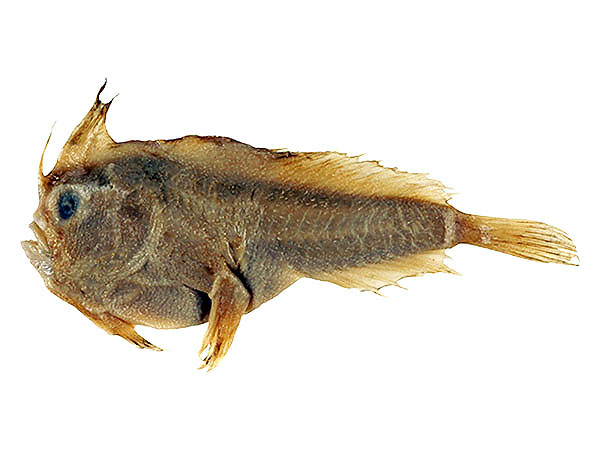
https://creativecommons.org/licenses/by-nc/3.0/au/deed.en
*********************
edited: 22.02.2024
Cyprinodon latifasciatus Garman
The Parras Pupfish was described in 1881, it was restricted to a spring or rather a series of springs in the valley that connects with Laguna de Mayrán near the city of San Pedro in Coahuila, Mexico.
Though some of these springs still exist, they do not harbour their former inhabitants any longer, but instead are filled with intentionally introduced Mosquitofish (Gambusia affinis (Baird & Girard)), Guppys (Poecilia reticulata Peters), and Swordtails (Xiphophorus helleri Heckel).
The Parras Pupfish was last seen in the 1930s and is now extinct.
*********************
References:
[1] M. L. Lozano-Vilano; M. De La Maza-Beningnos: Diversity and status of Mexican killifishes. Journal of Fish Biology 90(1): 1-36. 2016
*********************
edited: 27.05.2019
Cyprinella lutrensis ssp. blairi (Hubbs)
The Maravillas Red Shiner was restricted to the Garden Springs and the Pena Colorado Creek, which are a part of the Maravillas Creek drainage, a tributary of the Rio Grande in the Big Bend region of Texas, USA.
This subspecies reached a length of about 4,4 cm
The Maravillas Red Shiner disappeared in the late 1950s due to competition with introduced, invasive Plains Killifish (Fundulus zebrinus Jordan & Gilbert).
***
Some biologists consider the Maravillas Red Shiner synonymous with the nominate form.
*********************
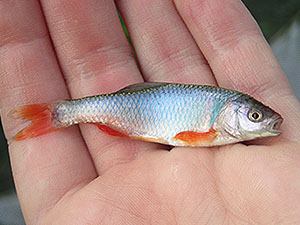
Red Shiner (Cyprinella lutrensis (Baird & Girard)); nominate form
Photo: Marine discovery
https://creativecommons.org/licenses/by-sa/4.0/
*********************
edited: 18.05.2022
Acanthobrama centisquama Heckel
The Orontes Bream, aka. Long-spine Bream, described in 1843; it was restricted to Lake Amik in Turkey as well as some water bodies in the Ghab Plain in Syria, which both obtain their water from the Orontes River.
Lake Amik was drained in the 1940 to obtain land for growing cotton but also to eliminate malaria; and the swampy areas in the Ghab Plan were drained in the 1950s, more or less for the same reasons.
The Orontes Bream is now most likely completely extinct.
*********************
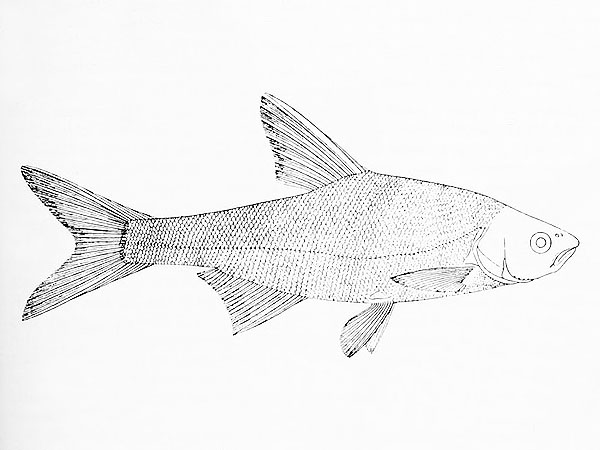
Depiction from: ‘M. Goren; L. Fishelson; E. Trewavas: The cyprinid fishes of Acanthobrama Heckel and related genera. Bulletin of the British Museum (Natural History) Zoology 24(6): 293-315. 1973’
The Trustees of the Natural History Museum, London
(under creative commons license (4.0))
https://creativecommons.org/licenses/by-nc-sa/4.0/
*********************
edited: 30.04.2021
Xenoclarias eupogon (Norman)
Lake Victoria Deepwater Catfish (Xenoclarias eupogon)
The Lake Victoria Deepwater Catfish, described in 1928, is endemic to Lake Victoria.
The species was last caught in the late 1980s; like many other endemic fish species, it begun to disappear after the introduction of Nile Perches (Lates niloticus (L.)) to the lake, but increased eutrophication of the lake and possibly also overfishing may have played a role in the possible extinction of this species.
*********************
edited: 16.02.2024
Cyprinus ilishaestomus Chen & Huang
Qilu Carp (Cyprinus ilishaestomus)
The Qilu Carp was described in 1977; it was endemic to the Qilu Lake in Yunnan, China.
This species was last found in the late 1970s and is now very likely extinct.
*********************
edited: 18.05.2022
Cyprinus yunnanensis Tchang
Yunnan Carp (Cyprinus yunnanensis)
The Yunnan Carp was described in 1933; it was restricted to Lake Qilu in Yunnan, China.
The littoral zone of the lake was destroyed by agricultural development, leading to a drop in the water level due to water extraction; furthermore, many species of foreign fish appear to have been introduced to the lake and probably feeding upon the eggs and larvae of the native fish species.
The Yunnan Carp was last found in the 1970s and is now apparently extinct.
*********************
edited: 15.02.2024
Knipowitschia cameliae Nalbant & Oţel
The Danube Delta Dwarf Goby is a very small freshwater goby that is only known from a single small lagoon south of the Danube Delta in Romania, where it inhabited shallow brackish and fresh water, usually less than 1 m deep.
The species reached a length of only about 3 cm; it was greyish colored and its body was covered with small blackish spots.
The Danube Delta Dwarf Goby was last seen in 1994, since then it is lost without any trace and appears to be extinct.
*********************
edited: 12.05.2022
Cyprinus micristius Regan
Dianchi Carp (Cyprinus micristius)
The Dianchi Carp was described in 1906; it is, or rather was, endemic to lake Dianchi in Yunnan, China.
The species was last seen in the 1960s and is now very likely extinct; it is said, however, that the tributaries of Lake Dianchi are maybe inhabited by one or more subspecies that might be still existing.
***
syn. Mesocyprinus micristius (Regan)
*********************
edited: 18.05.2022
Cyprinodon nevadensis ssp. calidae Miller
Tecopa Pupfish (Cyprinodon nevadensis ssp. calidae)
The Tecopa Pupfish was described in 1948, it was restricted to some outlets of the North- and South Tecopa Hot Springs in Inyo County, California, USA.
The two hot springs that this fish inhabited were very popular in the 1950s and 60s and were used for recreationally purposes; bathhouses were built, the spring pools were enlarged and their outflows were diverted which resulted in swifter currents which again caused the water temperatures downstream to rise above the level to which this pupfish was adapted.
All these modifications also allowed a subspecies closely related to this form, the Amargosa River Pupfish (Cyprinodon nevadensis ssp. armagosae Miller), to invade the Tecopa Pupfish’s habitat and to hybridize with it.
The last presumed Tecopa Pupfishs were recorded in 1966, but these, having ‘too small’ scales, may already have been hybrids.
*********************
edited: 27.05.2019
Cyprinus qionghaiensis Chen-Han Liu
Lake Qiong Carp (Cyprinus qionghaiensis)
This species is, or rather was, restricted to Lake Qiong, a 10 km² large lake in Yunnan.
The species disappeared after the introduction of European Carps (Cyprinus carpio L.) into the lake and is now considered most likely extinct.
*********************
edited: 16.05.2021
Anabarilius macrolepis P. L. Yih & C. K. Wu
This species was restricted to the Yilong Lake in Yunnan, China; in 1981, this lake dried out completely for about 20 days as a consequence of water extraction for agriculture.
The Yilong Whitefish had no chance to survive and is now extinct.
*********************
edited: 27.01.2022
Anabarilius yangzonensis Y. R. Chen & X. L. Chu
The Yangzong Whitefish, which was described in 1980, was restricted to the Yangzong Lake in Yunnan, China.
The populations of the species collapsed due to pollution and the introduction of non-native fish species; it has not been found during the most recent surveys in 2008 and might well be extinct.
*********************
edited: 27.01.2022
Acanthobrama tricolor (Lortet)
Damascus Bream (Acanthobrama tricolor)
The Damascus Bream was described in 1883; it was restricted to water bodies on the Golan Heights in Syria; most of which are now either dried up or heavily polluted.
The last specimens were found in the late 1980s in the Masil al Fawwar river system, it might now be completely extinct.
*********************
edited: 30.04.2021
Cyprinodon ceciliae Lozana-Vilano & Contreras-Balderas
Presa Pupfish (Cyprinodon ceciliae)
The Presa Pupfish was described in 1993, when it was already extinct.
The species was restricted to small creeks and ditches around La Presa Spring near the city of Aramberri in Nuevo León in Mexico; all of these are now completely dry due to excessive pumping of groundwater for agricultural purposes.
The Presa Pupfish, which reached an rather impressive size for a pupfish of up to 7 cm, was last seen in 1988 and is now extinct.
*********************
References:
[1] M. L. Lozano-Vilano; M. De La Maza-Beningnos: Diversity and status of Mexican killifishes. Journal of Fish Biology 90(1): 1-36. 2016
*********************
edited: 27.05.2019
Cyprinodon arcuatus Minckley & Miller
Santa Cruz Pupfish (Cyprinodon arcuatus)
The Santa Cruz Pupfish, also known as Monkey Spring Pupfish, was endemic to the Santa Cruz River system in Santa Cruz County in Arizona, USA, where it apparently was restricted to the margins of an artifical pond fed by an irrigation canal from Monkey Spring.
The species reached a size of about 3,8 cm.
The Santa Cruz Pupfish disappeared around 1970, due to the introduction of Largemouth Basses (Micropterus salmoides (Lacépède)) for ‘sport’ fishing. The species was kept in captivity for some times but breeding efforts were unsuccessful so that the Santa Cruz Pupfish is now extinct.
*********************
edited: 27.05.2019
Schistura nasifilis (Pellegrin)
The Nose-thread Stone Loach is known from two rivers in Vietnam, Ko and Tan in Annam; it was described in 1936 and was never recorded again since and is probably extinct.
*********************
edited: 21.04.2022
Barbodes truncatulus (Herre)
The Truncataed Bitungu was described in 1924; it was restricted to Lake Lanao on the island of Mindanao, Philippines.
The species fell victim to introduced predatory fish as well as likewise introduced invasive competitor fish species; it was last seen in 1973 and is now extinct.
*********************
edited: 29.04.2022
Platytropius siamensis (Sauvage)
The Siam Schilbid Catfish was described in 1883; it is known from the Chao Phraya- and the Bang Pakong river drainages in Thailand.
The species reached lengths of about 20 cm and is known to have been carnivorous, feeding on insects and their larvae as well as on freshwater shrimps.
The Siam Schilbid Catfish has not been recorded since the middle 1970s and is now considered extinct.
*********************
edited: 22.04.2022
Evarra eigenmanni Woolman
Plateau Chub (Evarra eigenmanni)
This Plateau Chub was described in 1894, it inhabited freshwater channels in the Chalco – and the Xochimilco-Tláhuac area in the Valley of Mexico, a region that is no longer existent due to the unstoppable growth of Mexico City.
The species apparently disappeared at around 1954.
*********************

(public domain)
*********************
edited: 10.05.2021
Labeobarbus microbarbis (Poll & David)
The Luhondo Yellowfish was described in 1937; it was endemic to Lake Luhondo in Rwanda and is only known from the type specimen.
The species started to disappear in the late 1930s after the introduction of cichlid species, including tilapias, into the lake, which outcompeted the native fish species.
*********************
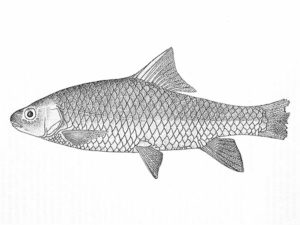
Depiction from: ‘Keith Edward Banister: A revision of the large Barbus (Pisces, Cyprinidae) of east and central Africa. Studies on African Cyprinidae. Part II. Bulletin of the British Museum (Natural History) Zoology 26: 1-147. 1973’
https://creativecommons.org/licenses/by-nc-sa/4.0/
*********************
edited: 16.05.2022
Lepidomeda altivelis Miller & Hubbs
Pahranagat Spinedace (Lepidomeda altivelis)
The Pahranagat Spinedace was described in 1960; the species is known from the outflows of The Ash Spring in the Pahranagat Valley in Nevada, USA, it preferred moderately swift, clear water.
The species was last recorded in 1938 and is now considered extinct; it disappeared most likely due to competition with- and predation by introduced fish- and frog species.
*********************
edited: 24.02.2024
Batrachoides walkeri Collette & Russo
Walker’s Toadfish was described in 1981; it is known only from the holotype that was found 1953 in the Panama Bay, Panama.
The type locality is considered to be in an eutrophic state due to ongoing pollution from agricultural- and livestock operations as well as from urban wastewaters from Panama City; Walker’s Toadfish might well be extinct now.
*********************
edited: 16.05.2022
Salmo schiefermuelleri Bloch
May Trout (Salmo schiefermuelleri)
This is a quite enigmatic species, described in 1784, whose taxonomic status isn’t clear.
The May Trout is rather known from anecdotes about trouts that inhabited the deep parts of the lakes within the Danube basin in Austria, and which only in the month of May appeared in shallow waters to breed.
***
The status of this species, as said above, is far from being clarified, if it indeed was a distinct species it appears to be extinct now.
*********************
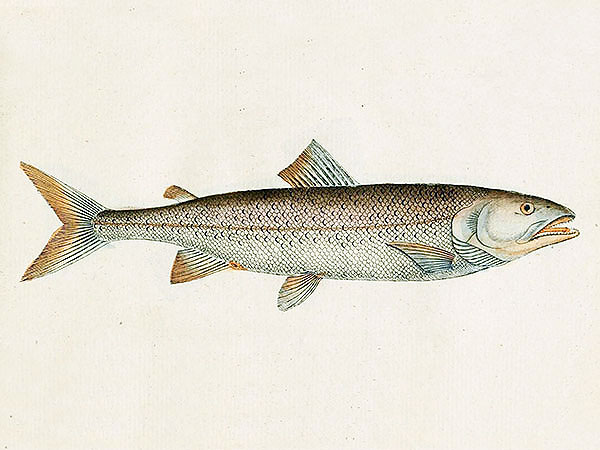
(public domain)
*********************
edited: 11.06.2020
Acanthobrama hulensis (Goren, Fishelson & Trewavas)
Hula Bream (Acanthobrama hulensis)
The Hula Bream was described in 1973; it was endemic to the swampy- and freshwater areas of Lake Hula in northern Israel.
The species reached a length of 23 cm; it was a bottom feeder which fed on mollusks and zooplankton.
When the lake was drained in the 1950s to obtain land for agriculture, this fish species died out; the last specimens were found in 1975.
*********************
edited: 30.04.2021
Tristramella sacra (Günther)
Long Jaw Tristramella (Tristramella sacra)
The Long Jaw Tristramella was endemic to the so-called Sea of Galilee, also known as Lake Tiberias, a small freshwater lake in northern Israel.
The species reproduced by spawning in the marshy northern part of the lake; this part of the lake, however, dried out repeatedly during the 1990s, resulting in the disappearance of this fish species.
The Long Jaw Tristramella is now extinct.
*********************
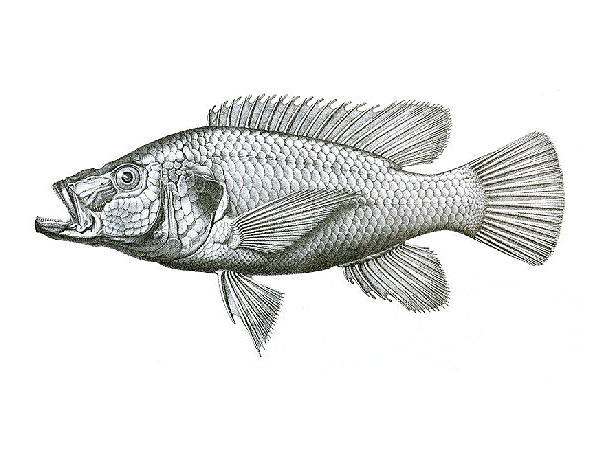
(public domain)
*********************
edited: 07.05.2021
Anabarilius qiluensis Y. R. Chen & X. L. Chu
The Qilu Whitefish was endemic to Lake Qilu in Yunnan, China.
The species disappeared after the introduction of non-native fish species into the lake around 1964; it was last seen in the early 1980s and is now considered most likely extinct.
*********************
edited: 27.01.2022
Schistura myrmekia (Fowler)
The Hua Hin Stone Loach was described in 1935 based on a single specimen that was found at near the city of Hua Hin in the Prachuap Khiri Khan province in southwestern Thailand.
The single known specimen is a 5,8 cm long male; in life it was of a light yellowish brown with small, dark spots on top of the head and eight dark bars along the body sides.
The species was never found since its description and is quite likely extinct.
*********************
References:
[1] Randal A. Singer; Lawrence M. Page: Redescription of Schistura myrmekia (Fowler 1935) (Teleostei: Nemacheilidae). Zootaxa 3586: 347-352. 2012
*********************
edited: 21.04.2022
Cyprinodon inmemoriam Lozano-Vilano & Contreras-Balderas
La Trinidad Pupfish (Cyprinodon inmemoriam)
The La Trinidad Pupfish was described in 1993, when it was already extinct.
The species was discovered in March 1984 in a spring named Ojo de Agua La Trinidad in the city of Aramberri in Nuevo León, it was then found extinct, just 18 months later in October 1985.
*********************
References:
[1] M. L. Lozano-Vilano; M. De La Maza-Beningnos: Diversity and status of Mexican killifishes. Journal of Fish Biology 90(1): 1-36. 2016
*********************
edited: 27.05.2019
Tristramella simonis ssp. magdalenae (Lortet)
Damaskus Tristramella (Tristramella simonis ssp. magdalenae)
This subspecies of the Short Jaw Tristramella (Tristramella simonis (Günther)) was restricted to the swamps and pools around Damaskus, the capital of Syria.
These marshy regions have been drained since the 1950s and this fish is now extinct.
***
syn. Chromis magdalenae Lortet, Tristramella magdalenae (Lortet)
*********************

(public domain)
*********************
edited: 07.05.2021
Barbodes baoulan Herre
Baolan Barbel (Barbodes baoulan)
The Baolan Barbel, locally known as Baolan, was endemic to Lake Lanao on the island of Mindanao, Philippines, where it was said to inhabit deeper waters.
The species reached a length of about 11 cm.
The fish is known from only nine specimens, despite being one of the most highly esteemed for food and apparently the rarest and most difficult to obtain. It is said to have only been caught during the colder months, and only after a storm with the waves still running high.
The species was reportedly last caught in 1963 to 1964, it is now feared to be extinct.
*********************
edited: 27.03.2017
Mugilogobius amadi (Weber)
Poso Bungu Goby (Mugilogobius amadi)
The Poso Bungu Goby was described in 1913.
The species was endemic to Lake Poso on the island of Sulawesi, Indonesia.
The fish reached a length of around 14.5 cm and was colored a solid dark brown to black.
***
The Poso Bungu Gobies were last recorded in 1987, but their trace has been lost since then. The disappearance of the species is probably caused by alien fish (which ones?) that were released into Lake Poso.
***
The photo below shows another, closely related species, Sarasin’s Goby (Mugilogobius sarasinorum(Boulenger)), which is also inhabiting waters in Sulawesi, Indonesia.
***
syn. Gobius amadi Weber Weberogobius amadi (Weber)
*********************

Photo: fachrynurmallojr
https://www.inaturalist.org/people/fachrynurmallojr
https://creativecommons.org/licenses/by-nc/4.0/
*********************
edited: 12.02.2024
Coregonus hiemalis Jurine
Gravenche (Coregonus hiemalis)
The Graveche, also known as Kilch, Kleine Fera or Lake Geneva Whitefish was endemic to Lake Geneva, where it was formerly one of the most commonly caught species.
The species reached lengths of 25 to 32 cm, it lived mainly among or near the lake’s bottom where it fed on tiny to tiniest organisms.
***
Despite being one of the most common species of the lake, the species was already disappearing during the 19th century, so the catching size for this species in Switzerland was officially set to above 20 cm in 1887.
This effort, however, came too late, the Graveche disappeared completely and is now globally extinct.
*********************
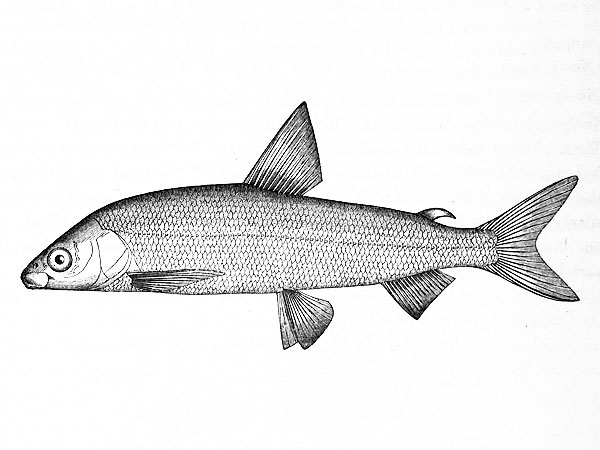
(not in copyright)
*********************
edited: 21.03.2018
Rhizosomichthys totae (Miles)
Lake Tota Feeler Fish (Rhizosomichthys totae)
The Lake Tota Feeler Fish is known from only ten specimens that were caught between 1942 and 1957 in the Lake Tota and is now considered extinct.
This about 14 cm long, incredibly ugly fish is unique among Pencil Catfishes in possessing remarkable rings of extensive adipose tissues surrounding its body, and giving it a somewhat large intestine-like appearance.
So far, nothing is known about its biology, the extinction was probably caused on the one hand by the introduction of the Rainbow Trout (Oncorhynchus mykiss (Walbaum)), and on the other hand by the subsidence of the water level due to seismic activities.
*********************
References:
[1] Scott A. Schaefer; Luis Fernández: Redescription of the Pez Graso, Rhizosomichthys totae (Trichomycteridae), of Lago de Tota, Colombia, and Aspects of Cranial Osteology Revealed by Microtomography. Copeia 2009(3): 510-522. 2009
*********************
edited: 21.03.2018
Barbodes herrei (Fowler)
Herre’s Barbel (Barbodes herrei)
Herre’s Barbel was described in 1935, it was endemic to Lake Lanao on the island of Mindanao, Philippines.
The species was not caught in recent years and is now considered most likely extinct.
*********************
edited: 27.03.2017
Coregonus sp. 2 ‘Dragon Lake’
Dragon Lake Whitefish (Coregonus sp. 2)
The Dragon Lake is a 2,25 km² resp. 225 ha large lake in British Columbia, it is a popular destination for anglers and well known for its large rainbow trouts (Oncorhynchus mykiss (Walbaum)) – however, that wasn’t always so.
***
The lake was once the home for two sympatric whitefish species – both species have never been described, and both species fell victim to a so called ‘lake rehabilitation’ in the year 1956.
The term ‘rehabilitaion’ disguises the pervert idea, to reshape a lake appropriate for so called game fishes by using insecticides like rotenone and toxaphene, both of which are simply deadly for fishes, to exterminate all living things, so that, later, when the poisons have vanished from the water of the now dead lake, the desired game fishes can be introduced – in the case of the Dragon Lake rainbow trouts.
***
The Dragon Lake Whitefish was similar to the Lake Whitefish (Coregonus clupaeformis (Mitchill)), but differed from this species in the number of its gill rakers.
*********************
edited: 03.12.2012
Cyprinus yilongensis Yang et al.
Lake Yilong Carp (Cyprinus yilongensis)
This species, as its name implies, was restricted to Lake Yilong in the Yunnan Province of China.
The species disappeared around the 1980s when the lake was drained.
*********************
edited: 16.05.2021
Caecocypris basimi Banister & Bunni
The Haditha Cavefish was described in 1980 based on material that was collected in 1977 from aquifers, underground layers of water-bearing rocks, near the city of Haditha, Iraq.
The groundwater level has drastically lowered since than due to water extraction; the species hasn’t been found since 1983, despite comprehensive surveys and appears to be extinct now.
*********************
edited: 09.08.2022
Barbodes disa Herre
Diza Barbel (Barbodes disa)
This species, locally known as Diza, was endemic to Lake Lanao on the island of Mindanao, Philippines.
The fish reached a length of about 9 cm.
The Diza Barbel was reportedly last caught in 1963/64 and is now considered most likely extinct.
*********************
edited: 27.03.2017
Tristramella simonis ssp. intermedia Steinitz & Ben-Tuvia
Lake Hula Tristramella (Tristramella simonis ssp. intermedia)
This subspecies of the Short Jaw Tristramella (Tristramella simonis (Günther)) was endemic to the Lake Hula (or Huleh) in Israel.
The species died out when the lake was drained in the 1950s for agricultural purposes.
*********************
edited: 07.05.2021
Evarra tlahuacensis Meek
Endorheic Chub (Evarra tlahuacensis)
The Endorheic Chub was described in 1902, the species was endemic to the Lago de Chalco in the Valley of Mexico.
This lake is now completely dry, and thus the endemic fish species are extinct.
*********************
edited: 20.01.2020
Barbodes amarus Herre
Bitter Barbel (Barbodes amarus)
This species, which locally is known as Dipura or Pait, was endemic to Lake Lanao on the island of Mindanao, Philippines.
The species reached a length of about 11 cm.
The species was reportedly last caught in 1982, all subsequent surveys failed to record it and it is now feared to be extinct.
***
The causes for the extinction of so many endemic fish species from Lake Lanao are the excessive exploitation of fish, which is the main diet for the increasing human population in the area; the traditional fishing methods having been replaced by dynamite fishing, which simply destroys and kills everything, and by the use of several poisons.
*********************
edited: 27.03.2017
Barbodes palaemophagus Herre
This species was described in 1924; it was endemic to Lake Lanao on the island of Mindanao, Philippines.
In the 1960s, the Tank Goby (Glossogobius giuris (F. Hamilton)), a predatory fish species was accidently introduced to the lake, leading to the extinction of several endemic fish species. However, overfishing, rampant use of destructive fishing methods (dynamite fishing), and unsustainable fishing practices certainly played their part too.
The Bitungu was last recorded in 1975 and is now extinct.
*********************
edited: 29.04.2022
Cottus echinatus Bailey & Bond
Described in 1963, the Utah Lake Sculpin was restricted to Lake Utah, a shallow freshwater lake in Utah, USA
The species is thought to have died out due to a severe drought in the 1920s and 1930s that led to a rapid fall of the water levels, followed by a cold winters in which the lake was freezing resulting in a congestion of the remaining fish in a few open spots, resulting in food shortages and lack of oxygen.
However, during the same years, the water quality had apparently significantly worsen due to the entry of waste water by agriculture etc..
***
The last Utah Lake Sculpin was caught in 1928.
*********************
edited: 02.08.2022
Barbodes tras Herre
Tras Barbel (Barbodes tras)
The Tras Barbel, which was locally known as Tras, was endemic to Lake Lanao on the island of Mindanao, Philippines.
The fish reached a length of about 12,5 cm.
The species, which was described in 1926, is now feared to be extinct.
*********************
edited: 27.03.2017
Evarra bustamantei Navarro
Mexican Chub (Evarra bustamantei)
The Mexican Chub is one of three known species in this genus, all of them are now extinct due to habitat loss.
***
This Mexican Chub was described in 1955, it inhabited canals and streams in the Valley of Mexico, a plateau in central Mexico that now is nearly completely overbuilt by Mexico City, one of the largest cities on the planet.
The species died out at around 1983 as a result of the complete drying of the water bodies in the valley due to the withdrawal of water by the agriculture and the unstoppable growth of the city and its suburbs.
*********************
edited: 20.01.2020
Rhinichthys deaconi R. R. Miller
Las Vegas Dace (Rhinichthys deaconi)
The Las Vegas Dace was described in 1984, it was declared extinct in 1986, only two years later.
***
The Las Vegas Valley in Nevada, USA originally was formed by a river, this river, however, started to disappear at 4000 to 1000 BCE., leaving behind only three springs and becoming merely a dry wash.
The last Las Vegas Daces were cought in 1940 (but were not recognized as being distinct), they apparently survived in one of the springs and outflows until 1955 to 1957, but disappeared sometimes before 1967.
The creek that formerly held the three springs is now obviously completely dry.
*********************
References:
[1] Robert Rush Miller: Rhinichthys deaconi, a new species of dace (Pisces: Cyprinidae) from southern Nevada. Occasional Papers of the Museum of Zoology University of Michigan 707: 1-21. 1984
*********************
edited: 23.04.2019
Notholebias cruzi (W. J. E. M. Costa)
Cruz’s Pearlfish (Notholebias cruzi)
This species was described in 1988, it was restricted to the coastal plains near Rio São João, Rio de Janeiro in southeast Brazil.
Cruz’s Pearlfish reached a length of only about 3 to 4 cm.
***
The genus Notholebias contains at least four species, one of which is already extinct, the remaining three are close to extinction.
*********************
References:
[1] Wilson J. E. M. Costa; Pedro F. Amorim: Delimitation of cryptic species of Notholebias, a genus of seasonal miniature killifishes threatened with extinction from the Atlantic Forest of south-eastern Brazil (Cyprinodontiformes: Rivulidae). Ichthyological Exploration of Freshwaters 24(1): 63-72. 2013
*********************
edited: 31.10.2017
Gambusia georgei Hubbs & Peden
San Marcos Mosquitofish (Gambusia georgei)
The San Marcos Mosquitofish was described in 1969.
The species was restricted to the San Marcos Spring, a large vegetated spring, and its effluent in Hays County, Texas, USA.
The San Marcos Mosquitofish reached a length of about 4 cm, the species was live bearing, a large female could give birth to up to 60 young.
The species disappeared due to a mix of influences, including the pollution of the water by sprayed herbicides along the San Marcos River, and the introduction of another Gambusia species, the Western Mosquitofish (Gambusia affinis (Baird & Girard)), with which it hybridized.
The last pure San Marcos Mosquitofish were seen in 1983.
*********************
edited: 23.06.2020
Barbodes pachycheilus Herre
Thick-lipped Barbel (Barbodes pachycheilus)
The Thick-lipped Barbel was endemic to Lake Lanao on the island of Mindanao, Philippines.
The species is known only from the type specimen that was collected in 1921, it was never recorded again and is considered most likely extinct.
***
The local name of the fish was Bongkaong.
*********************
edited: 27.03.2017
